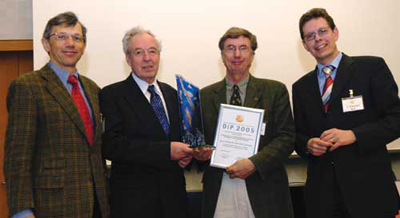

Organ
of the
GD — Society for Dermopharmacy
 |
Issue 1 (2005) |
GD News
Award for successful development of test methods for reduction of animal experiments
Professor Dr. med. Horst Spielmann, Berlin, awarded with DIP 2005
In the course of 9th Annual Meeting of the GD Gesellschaft für Dermopharmazie, professor Dr. med. Horst Spielmann, Berlin, was awarded by the GD with the Dermopharmacy-Innovation-Prize (DIP) in Vienna on 15th March. The GD honours outstanding innovative achievements in the field of Dermopharmacy by the DIP which has been awarded for the second time this year. The laureate is determined by an interdisciplinary composed curatorship consisting of a dermatologist, a pharmacist and a cosmetic chemist. Spielmann has been awarded with the DIP for his successful development of test procedures aiming at the reduction of animal experiments, which is exemplary world-wide.
Professor Dr. med. Horst Spielmann is head of the Zentralstelle zur Erfassung und Bewertung von Ersatzmethoden zum Tierversuch (ZEBET) (Corporate Center of Registration and Assessment of Substitution Methods for Animal Experiments) at the Bundesinstitut für Risikobewertung (BfR) (Federal Institute for Risk Assessment) in Berlin. He has been heading the first institution since 1989 world-wide setting a focus on this task. Meanwhile there are similar research institutions also in other countries. Moreover, Spielmann is member of the GD committee. The often strenuous paths to substitute animal experiments were also subject to a GD symposium in cooperation with the BfR and the Free University Berlin, in Berlin on 25 November 2004. Spielmann was member of the scientific conference management for this symposium.
 Professor Dr. med. Horst Spielmann (2nd person right) has been awarded with the Dermopharmacy Innovation Prize (DIP) of the Gesellschaft für Dermopharmazie for his successful development of test procedures for the reduction of animal experiments. On the occasion of handing over of the DIP in the course of 9th GD Annual Meeting in Vienna, the scientific conference head professor Dr. med. Werner Aberer, the speaker of the curatorship professor Dr. Wolfgang Wiegrebe and the GD-president Dr. Joachim Kresken (from left) congratulated. |
The speaker of the DIP curatorship, professor Dr. Wolfgang Wiegrebe, Regensburg, emphasized in his laudation the ethically essential work. He highlighted two models as especially important results of Spielmann's work: mouse fibroblast for the test of photo toxicity and - mutagenicity and keratinocytes cultures for the test on irritation by chemicals. The results of such tests have to be quantitatively evaluable and reproducible. The keratinocyte model fulfils these requirements in a striking way. It allows a quantitative statement for the degree of damage and even entails a correction of the human pharmacological results by means of a color reaction.
Wiegrebe recognized the extensive detailed work required for the elaboration of such procedures and explicitly included juridical aspects in his explanations. Just as the keratinocytes test contributed to the correction of the hitherto existing perceptions, in reverse the individual case of an erroneous result can never be completely excluded. Therefore, the awarding by the DIP is also to foster the efforts in a case of the type. In this context Wiegrebe criticized the widespread behaviour of the public media either not having sufficient background knowledge or not to be able to quantify an unavoidable residual risk.
top